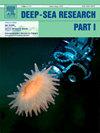深海独立式数字锥的设计与实验
IF 2.1
3区 地球科学
Q2 OCEANOGRAPHY
Deep-Sea Research Part I-Oceanographic Research Papers
Pub Date : 2025-09-23
DOI:10.1016/j.dsr.2025.104600
引用次数: 0
摘要
海底土壤特性在海洋工程中有着广泛的应用。本研究提出了一种独特的、符合国际标准的、适合深海作业的独立锥体设计。该设计旨在解决和克服锥体穿透测试探头目前面临的局限性,例如与杆连接和信号衰减有关的问题。提出了一种基于倾斜的姿态校正算法来获取垂直侵彻位移。此外,在探头上施加的载荷与记录的应变片信号之间建立了校准曲线。基于理论计算和有限元模拟实验,分析研究了深海高压环境、密封圈摩擦等环境因素对侵彻测量结果的影响。同时进行了潮平试验。通过将探头采集的数据与叶片剪切试验数据进行对比,验证了探头的准确性。在最后实施阶段,该锥被引入中国南海一个特别设计的CPT站。获得的岩土参数与之前检测的地层特征基本吻合,证实了锥筒在深海环境中进行原位测量工作的可靠性和有效性。本文章由计算机程序翻译,如有差异,请以英文原文为准。
Design and experimentation of self-contained digital cone for deep sea
Seabed soil properties play an essential role in a wide range of marine engineering applications. This study presents the design of a distinctive self-contained cone that is in line with international standards and suitable for deep-sea operations. This design aims to address and overcome the current limitations faced by cone penetration testing probes, such as problems related to rod connections and signal attenuation. An inclination-based posture correction algorithm was introduced to obtain vertical penetration displacement. Additionally, a calibration curve was established between applied load on the probe and the recorded strain gauge signal. Based on theoretical calculations and finite element simulation experiments, an analysis and research were carried out on the impact of deep-sea environmental factors, such as high-pressure environments and seal ring friction, on penetration survey results. Simultaneously, a tidal flat test was performed. By comparing the data collected by the probe with that of the vane shear test, the accuracy of the probe was verified. In the final implementation stage, the cone was introduced to a specially designed CPT station in the South China Sea. The obtained geotechnical parameters largely corresponded with the previously examined strata characteristics, confirming the cone's reliability and effectiveness for in-situ survey work in deep-sea environments.
求助全文
通过发布文献求助,成功后即可免费获取论文全文。
去求助
来源期刊
CiteScore
4.60
自引率
4.20%
发文量
144
审稿时长
18.3 weeks
期刊介绍:
Deep-Sea Research Part I: Oceanographic Research Papers is devoted to the publication of the results of original scientific research, including theoretical work of evident oceanographic applicability; and the solution of instrumental or methodological problems with evidence of successful use. The journal is distinguished by its interdisciplinary nature and its breadth, covering the geological, physical, chemical and biological aspects of the ocean and its boundaries with the sea floor and the atmosphere. In addition to regular "Research Papers" and "Instruments and Methods" papers, briefer communications may be published as "Notes". Supplemental matter, such as extensive data tables or graphs and multimedia content, may be published as electronic appendices.

 求助内容:
求助内容: 应助结果提醒方式:
应助结果提醒方式:


